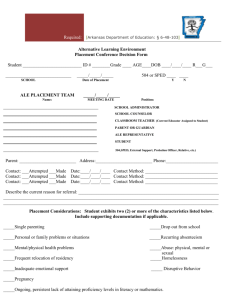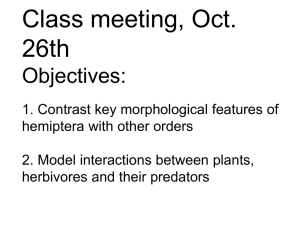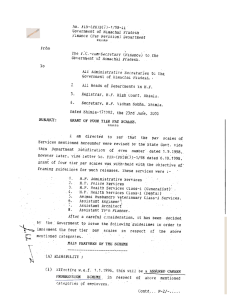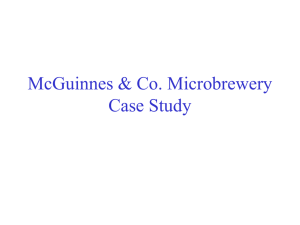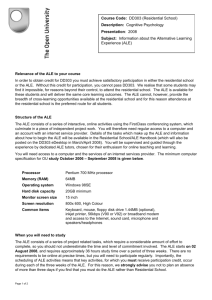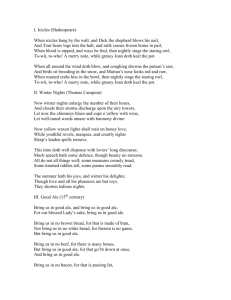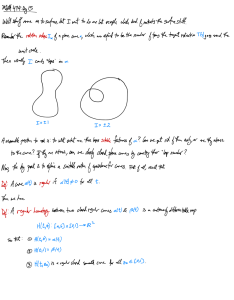Document 13308876
advertisement
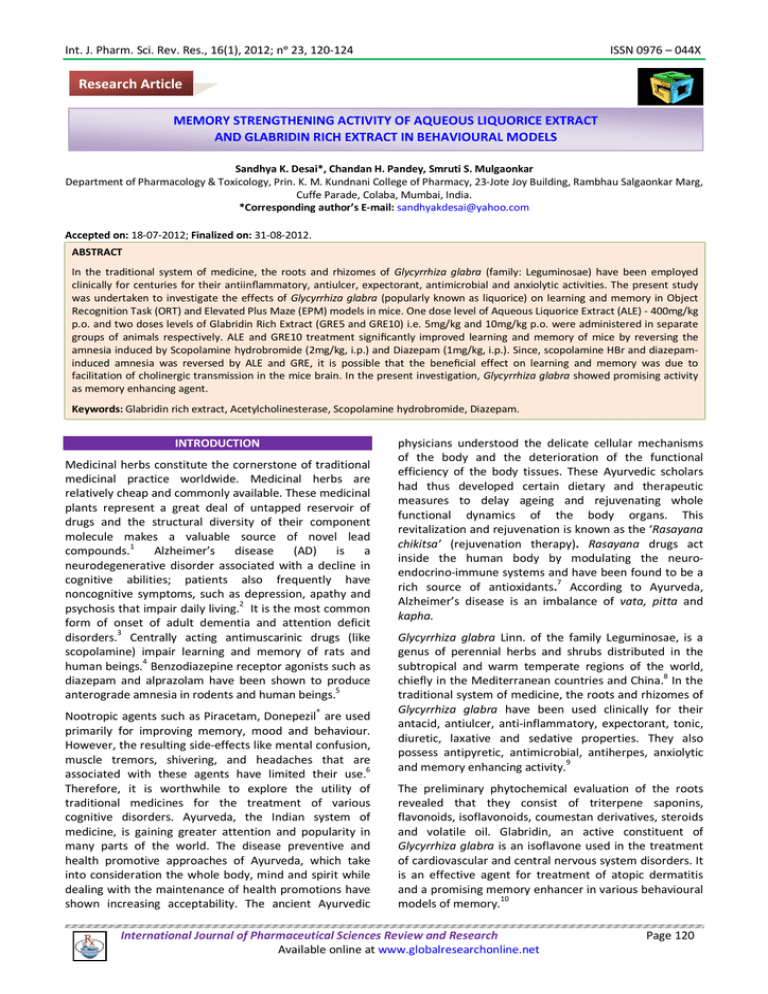
Int. J. Pharm. Sci. Rev. Res., 16(1), 2012; nᵒ 23, 120-124 ISSN 0976 – 044X Research Article MEMORY STRENGTHENING ACTIVITY OF AQUEOUS LIQUORICE EXTRACT AND GLABRIDIN RICH EXTRACT IN BEHAVIOURAL MODELS Sandhya K. Desai*, Chandan H. Pandey, Smruti S. Mulgaonkar Department of Pharmacology & Toxicology, Prin. K. M. Kundnani College of Pharmacy, 23-Jote Joy Building, Rambhau Salgaonkar Marg, Cuffe Parade, Colaba, Mumbai, India. *Corresponding author’s E-mail: sandhyakdesai@yahoo.com Accepted on: 18-07-2012; Finalized on: 31-08-2012. ABSTRACT In the traditional system of medicine, the roots and rhizomes of Glycyrrhiza glabra (family: Leguminosae) have been employed clinically for centuries for their antiinflammatory, antiulcer, expectorant, antimicrobial and anxiolytic activities. The present study was undertaken to investigate the effects of Glycyrrhiza glabra (popularly known as liquorice) on learning and memory in Object Recognition Task (ORT) and Elevated Plus Maze (EPM) models in mice. One dose level of Aqueous Liquorice Extract (ALE) - 400mg/kg p.o. and two doses levels of Glabridin Rich Extract (GRE5 and GRE10) i.e. 5mg/kg and 10mg/kg p.o. were administered in separate groups of animals respectively. ALE and GRE10 treatment significantly improved learning and memory of mice by reversing the amnesia induced by Scopolamine hydrobromide (2mg/kg, i.p.) and Diazepam (1mg/kg, i.p.). Since, scopolamine HBr and diazepaminduced amnesia was reversed by ALE and GRE, it is possible that the beneficial effect on learning and memory was due to facilitation of cholinergic transmission in the mice brain. In the present investigation, Glycyrrhiza glabra showed promising activity as memory enhancing agent. Keywords: Glabridin rich extract, Acetylcholinesterase, Scopolamine hydrobromide, Diazepam. INTRODUCTION Medicinal herbs constitute the cornerstone of traditional medicinal practice worldwide. Medicinal herbs are relatively cheap and commonly available. These medicinal plants represent a great deal of untapped reservoir of drugs and the structural diversity of their component molecule makes a valuable source of novel lead compounds.1 Alzheimer’s disease (AD) is a neurodegenerative disorder associated with a decline in cognitive abilities; patients also frequently have noncognitive symptoms, such as depression, apathy and psychosis that impair daily living.2 It is the most common form of onset of adult dementia and attention deficit 3 disorders. Centrally acting antimuscarinic drugs (like scopolamine) impair learning and memory of rats and 4 human beings. Benzodiazepine receptor agonists such as diazepam and alprazolam have been shown to produce anterograde amnesia in rodents and human beings.5 Nootropic agents such as Piracetam, Donepezil® are used primarily for improving memory, mood and behaviour. However, the resulting side-effects like mental confusion, muscle tremors, shivering, and headaches that are 6 associated with these agents have limited their use. Therefore, it is worthwhile to explore the utility of traditional medicines for the treatment of various cognitive disorders. Ayurveda, the Indian system of medicine, is gaining greater attention and popularity in many parts of the world. The disease preventive and health promotive approaches of Ayurveda, which take into consideration the whole body, mind and spirit while dealing with the maintenance of health promotions have shown increasing acceptability. The ancient Ayurvedic physicians understood the delicate cellular mechanisms of the body and the deterioration of the functional efficiency of the body tissues. These Ayurvedic scholars had thus developed certain dietary and therapeutic measures to delay ageing and rejuvenating whole functional dynamics of the body organs. This revitalization and rejuvenation is known as the ‘Rasayana chikitsa’ (rejuvenation therapy). Rasayana drugs act inside the human body by modulating the neuroendocrino-immune systems and have been found to be a rich source of antioxidants.7 According to Ayurveda, Alzheimer’s disease is an imbalance of vata, pitta and kapha. Glycyrrhiza glabra Linn. of the family Leguminosae, is a genus of perennial herbs and shrubs distributed in the subtropical and warm temperate regions of the world, chiefly in the Mediterranean countries and China.8 In the traditional system of medicine, the roots and rhizomes of Glycyrrhiza glabra have been used clinically for their antacid, antiulcer, anti-inflammatory, expectorant, tonic, diuretic, laxative and sedative properties. They also possess antipyretic, antimicrobial, antiherpes, anxiolytic 9 and memory enhancing activity. The preliminary phytochemical evaluation of the roots revealed that they consist of triterpene saponins, flavonoids, isoflavonoids, coumestan derivatives, steroids and volatile oil. Glabridin, an active constituent of Glycyrrhiza glabra is an isoflavone used in the treatment of cardiovascular and central nervous system disorders. It is an effective agent for treatment of atopic dermatitis and a promising memory enhancer in various behavioural 10 models of memory. International Journal of Pharmaceutical Sciences Review and Research Available online at www.globalresearchonline.net Page 120 Int. J. Pharm. Sci. Rev. Res., 16(1), 2012; nᵒ 23, 120-124 Therefore, the present research work was designed to explore and compare the memory enhancing activity of aqueous liquorice extract and Glabridin rich extract using Object recognition task and Elevated plus maze models. MATERIALS AND METHODS Experimental animals Albino swiss mice of either sex, weighing 20-30 gm were used for the experiment. They were housed under standard conditions (temperature 24˚- 28˚C, relative humidity 45-60% and 12 hr dark- light cycle) in clean polypropylene cages and were fed with standard rodent diet (Amrut laboratory animal feed, Pune, India) and water ad libtium. Experimental protocols were reviewed and approved by the Institutional Animal Ethics Committee (Animal House Registration No. 25/1999/CPCSEA). Acute toxicity study Acute oral toxicity studies have been carried out in albino wistar rats by oral route at dose levels up to 2000mg/kg of ALE, as per OECD guidelines No.423. As the rats were administered maximal possible dose, the LD50 value of the ALE could not be determined. Drugs and chemicals All the reagents and solvents used in the study were of analytical grade and commercially available viz: 5,5'dithio-bis-2-nitrobenzoic acid (DTNB) (Sigma Aldrich Chemicals, Germany), Scopolamine Hydrobromide, Acetylthiocholine iodide (Sigma Aldrich Chemicals, U.S.A.), Piracetam (IPCA Laboratory, India) and Diazepam (Calmpose® for injection, Ranbaxy Laboratories Ltd., India). Plant material and Preparation of the extract Aqueous Liquorice Extract (ALE):Fresh roots and stems of liquorice were collected from Sheetal herbal products and authenticated at Agharkar Research Institute, Pune. The roots and stems of liquorice were shade dried and pulverized in a grinder to a coarse powder. This powder was subjected to soxhlet extraction using distilled water. The aqueous extract was dried over water bath maintained at 100°C to get ALE. Glabridin Rich Extract (GRE):30gm of dried coarse powder of liquorice roots and stems was subjected to sonication by ethyl acetate for 30 min. The solvent was filtered and evaporated to dryness at 40°C to get a crude extract. This crude extract was dissolved in ethyl acetate-hexane (1:4 v/v) and subjected to column chromatography using various proportions of ethyl acetate-hexane viz: 1:4, 1:3, 1:2 and 1:1 v/v respectively. Each part of eluent was collected from the column and monitored through silica gel TLC. Fractions with similar spots were combined to obtain GRE.11,12 ISSN 0976 – 044X Object Recognition Task 13,14 Mice were divided into six groups of six animals each viz: control group (untreated), toxicant group (Scopolamine hydrobromide 2mg/kg, i.p.), standard treatment group (Piracetam 200mg/kg, p.o.), ALE treatment group (400mg/kg, p.o.) and GRE5 & 10 treatment groups (5mg/kg and 10mg/kg, p.o.). The standard, ALE and GRE were administered orally to the respective groups for 4 consecutive days, whereas toxicant scopolamine th hydrobromide was administered on the 5 day to all groups except the control group immediately after exposing them to training session. In training session mice were allowed to explore with two similar objects (Rubik cube of 5.4cm ×5.4cm ×5.4cm) for 5min. The retention memory was measured 24hr after training session in which mice were allowed to explore one familiar and one new dissimilar object for 5min. The time spent for exploring the familiar and the new dissimilar object was recorded and parameters like discrimination ratio and discrimination index were calculated. Elevated plus maze 15,16 Mice were divided into six groups of six animals each viz: control group (untreated), toxicant group (Diazepam 1mg/kg, i.p.), standard treatment group (Piracetam 200mg/kg, p.o.), ALE treatment group (400mg/kg, p.o.) and GRE5 & 10 treatment groups (5mg/kg and 10mg/kg, p.o.). The standard, ALE and GRE were administered orally to the respective groups for 15 consecutive days, whereas toxicant diazepam was administered 90 min after the administration of the last dose on 15th day. The animals were exposed to the training session after 45min of diazepam administration. In training session mice were placed at the end of an open arm and time taken by the animal to move from open to close arm of the elevated plus maze model was noted as Transfer Latency (TL). The retention memory was measured after 24hr in terms of TL i.e. on the 16th day and immediately animals in all the groups were humanely sacrificed using ether. Biochemical Estimation Collection of Brain samples th The animals were sacrificed using ether on the 16 day after measuring the transfer latency. The whole brain was carefully removed, weighed and transferred to a glass homogenizer and homogenized in 10%w/v 0.1M phosphate buffer pH 7.4. Estimation of Brain Acetycholinesterase (AChE) The whole brain AChE was measured using Ellman method.17,18 The endpoint was the formation of the yellow colour because of the reaction of thiocholine with dithiobisnitrobenzoate ions. The rate of formation of thiocholine from acetylthiocholine iodide in the presence of tissue cholinesterase was measured using a spectrophotometer at 412nm every minute for a period of 3min. AChE activity was calculated using following formula: International Journal of Pharmaceutical Sciences Review and Research Available online at www.globalresearchonline.net Page 121 Int. J. Pharm. Sci. Rev. Res., 16(1), 2012; nᵒ 23, 120-124 ISSN 0976 – 044X l, m p < 0.001 when Standard group was compared with GRE5 Where, R = Rate in moles substrate hydrolyzed per min per g of tissue, ∆A = Change in absorbance per min, Co = Original concentration of tissue (mg/ml). Statistical analysis The results were expressed as mean ± S.E.M (n=6). The statistical significance of differences between groups was determined by one way analysis of variance (ANOVA), followed by Tukey-Kramer test for multiple comparisons among groups by using GraphPad Instat version 5.0 of Graphpad software. Values of p <0.05 were considered statistically significant. Effect of ALE and GRE in Transfer latency (Elevated Plus Maze) Treatment with ALE (400mg/kg) and GRE5 & 10 (5mg/kg & 10mg/kg) groups significantly (p<0.001, p<0.01 & p<0.05) decreases transfer latency time as compared to toxicant group (Table 2). GRE5 treated group showed significant increase in TL (P<0.05) when compared with standard treated group. Therefore, GRE5 treatment group was not effective as that of Standard treatment. Table 2: Effect of ALE and GRE on Transfer latency in Elevated plus maze model in mice RESULTS Acute toxicity study ALE (400mg/kg) and GRE5 & 10 (5mg/kg and 10mg/kg) treated mice showed significant increase in discrimination ratio and discrimination index (p<0.001 & p<0.01) when compared with toxicant control group (Table 1). ALE and GRE10 do not show significant difference in discrimination ratio and discrimination index (P>0.05) when compared with standard (Piracetam- 200 mg/kg). Therefore, effect of GRE10 and ALE treated groups is equipotent to that of standard treated group. Table 1: Effect of ALE and GRE on Discrimination ratio and Discrimination index in mice Parameters / Groups Discrimination ratio Discrimination index Normal Control 0.5683 ± 0.0141 0.1843 ± 0.0050 Toxicant (Scopolamine 2mg/kg) 0.5085 ± 0.0028 Standard (Piracetam 200mg/kg) 0.6445 ± 0.0091 ALE (400mg/kg) 0.6250 ± 0.0117 x 0.2870 ± 0.0118 x GRE5 (5mg/kg) 0.5785 ± 0.0117 y 0.2004 ± 0.0115 y GRE10 (10mg/kg) 0.6517± 0.0185 x 0.2942 ± 0.0108 x a x, m 0.1275 ± 0.0082 0.2867 ± 0.0020 a Transfer Latency (sec) 40.850 ± 1.917 Toxicant (Diazepam 1mg/kg) Standard (Piracetam 200mg/kg) 59.408 ± 1.181 ALE (400mg/kg) GRE5 (5mg/kg) GRE10 (10mg/kg) ALE did not exhibit any toxic or deleterious effects upto a dose level of 2000 mg/kg orally. As the rats were administered up to maximal possible dose, the LD50 value of the ALE could not be determined. Effect of ALE and GRE in Discrimination ratio and Discrimination index (Object Recognition Task) Parameters / Groups Normal Control a 39.765 ± 3.1967 x x 41.483 ± 0.9163 y 47.292 ± 0.9438 x 40.927 ± 2.742 All values expressed as mean ± SEM, n = 6; One-way ANOVA followed by Tukey-Kramer test is applied for statistical analysis, P values: x < 0.001 when Experimental groups compared with Toxicant group y < 0.01 when Experimental groups compared with Toxicant group a p < 0.001 when Toxicant group compared with Normal Control Effect of ALE and GRE in Acetycholinesterase (Elevated Plus Maze) The AChE activity of whole brain was markedly elevated in toxicant (Diazepam 1mg/kg, i.p.) group (Figure 1). However, ALE and GRE treatment group showed significant (p<0.001, p<0.01, p<0.05) decrease in brain AChE activity compared to toxicant group. Piracetam used as standard drug also showed decrease in the brain AChE activity of mice. x, l All values expressed as mean ± SEM, n = 6; One-way ANOVA followed by Tukey-Kramer test is applied for statistical analysis. x P values: < 0.001 when Experimental groups compared with Toxicant group y < 0.01 when Experimental groups compared with Toxicant group a p < 0.05 when Toxicant group compared with Normal Control Figure 1: Effect of ALE and GRE on Acetylcholinesterase level in Elevated plus maze model in mice. International Journal of Pharmaceutical Sciences Review and Research Available online at www.globalresearchonline.net Page 122 Int. J. Pharm. Sci. Rev. Res., 16(1), 2012; nᵒ 23, 120-124 All values expressed as mean ± SEM, n = 6; One-way ANOVA followed by Tukey-Kramer test is applied for statistical analysis, x P value: < 0.001 when Experimental groups compared with Toxicant group z < 0.05 when Experimental groups compared with Toxicant group a < 0.001 when Toxicant group compared with Normal Control l < 0.05 Standard group compared with GRE5 DISCUSSION There has been a steady rise in the number of patients suffering from AD all over the world. AD is a genetically heterogeneous neurodegenerative disorder, which is slow onset but relentless in progress.19,20 There are around 35 million patients suffering from AD all over the world, out of which United States of America alone has around 4.5 million patients. Despite the severity and high prevalence of this disease, Allopathic system of medicine is yet to provide a satisfactory antidote. Therefore, neurobiologists all over the world are looking for new directions and alternative strategies for managing this disease of senior citizens. Therefore, we were motivated to explore the new approach in Indian traditional system to manage this deadly disease (AD). In the present study, we have focused upon exploring the potential of Aqueous liquorice extract (ALE- 400mg/kg) and Glabridin rich extracts at two dose levels (5mg/kg & 10mg/kg) in reversing the memory deficits. Amnesia was induced in mice and rats by intraperitoneal injection of Scopolamine / Diazepam in Object recognition task (ORT) and Elevated plus maze (EPM) models. Piracetam, the established nootropic agent was used as a standard in the present study. Acute toxicity of ALE did not show any toxic or deleterious effects upto 2000 mg/kg oral dose indicating low toxicity of ALE at high doses. As the rats were administered upto maximal possible dose, the LD50 value of ALE could not be determined. ORT is widely used to assess recognition memory performance in rodents. In ORT, administration of the anti-muscarinic agent scopolamine produces transient memory deficit which efficiently causes disruption of the memory in the recognition for the newer object in this task. In this model scopolamine is administered after the training session. Therefore, ability of mice to retain the learned behaviour of exploring the familiar object in training session is checked in test session (after 24hr of training session) in which one of the familiar objects is replaced with new object. In our study, we observed that in test session ALE and GRE10 treatment significantly increased the time spent for exploring the newer object which was measured in terms of discrimination ratio and discrimination index. The result of GRE5 was not ISSN 0976 – 044X comparable with ALE. The increment in discrimination index and discrimination ratio is the indication of the improvement in the memory. In EPM, diazepam, a GABA mimetic agent induces memory impairment and the subsequent inhibition of GABAA receptors has been found to facilitate learning and memory.21,22 In EPM, mice show natural aversion to open and high spaces and therefore it takes lesser time to enter in closed arms. It was suggested that Transfer latency (TL) might be shortened if the animal has previously experienced entering the closed arms. Therefore, the shortened TL is related to memory. In this study, GRE5 treatment was not as effective as the standard treatment in improving memory whereas ALE and GRE10 significantly reduced the TL when compared to toxicant control. Acetylcholine is considered as the most important neurotransmitter involved in the regulation of cognitive functions. Cholinergic transmission is terminated by acetylcholine hydrolysis via enzyme Acetylcholinesterase (AChE). This enzyme is essential in maintaining normal function of nervous system, since it rapidly terminates the action of acetylcholine released into the synapse. It is believed that the action of this enzyme could affect the underlying processes in AD. Consequently, AChE has been potential target for prevention and treatment of Alzheimer’s disease. ALE and GRE treatment inhibited AChE activity significantly in the brain when compared to toxicant control. The effects of ALE and GRE on AChE inhibition were comparable to standard Piracetam treatment. Our data suggest that the ameliorating effects on memory of ALE and GRE could be explained by their inhibition on AChE activity within the brain. This protective effect of ALE and GRE offered against diazepam induced amnesia might be due to indirect facilitation of Ach level in the brain. Thus, the memory improving activity of ALE and GRE may be attributed to its anti-acetylcholinesterase property and may be useful as a nootropic agent in delaying the onset and reducing the severity of Alzheimer’s disease. CONCLUSION In the present study, we observed that an Indian Ayurvedic herbal plant liquorice (Glycyrrhiza glabra) caused reduction in Acetylcholinesterase (AChE) levels in brain thus suggesting the anti-cholinesterase activity of ALE and GRE might be the probable mechanism for its memory enhancing activity. In the light of above discussion, it may be worthwhile to explore the potential of this plant in the prevention, treatment and management of Alzheimer’s disease. International Journal of Pharmaceutical Sciences Review and Research Available online at www.globalresearchonline.net Page 123 Int. J. Pharm. Sci. Rev. Res., 16(1), 2012; nᵒ 23, 120-124 REFERENCES 1. Vyawahare, N.S., Ambikar, D.B., Evaluation of Neuropharmacological Activity of Hydroalcoholic Extract of Fruits of Trapa bispinosa In Laboratory Animals, Int. J. Pharmacy Pharm. Sci., 2; 2010, 32-35. 2. Jewart, R.D., Green, J., Lu, C.J., Cellar, J., Tune, L.E., Cognitive, Behavioral, and Physiological Changes in Alzheimer Disease patients as a Function of Incontinence medications, Am. J. Geriatr. Psychiatry, 13; 2005, 324-328. 3. Mrudula, G., Rao, P.M., Jayaveera, K.N., Nootropic Activity of leaves of Prunella vulgaris, Research Journal of Pharmaceutical, Biological and Chemical Sciences, 1; 1998, 27-44. 4. Higashida, A., Ogawa, N., Differences in the acquisition process and the effect of scopolamine on radial maze performance in three strains of rats, Pharmacol. Biochem. Behav., 27; 1987, 483-489. ISSN 0976 – 044X 12. Gupta V., Fatima A., Faridi U., Negi A., Shanker K., Kumar J., Rahuja N., Luqman S., Sisodia B., Saikia D., Darokar M., Khanuja S., Antimicrobial potential of Glycyrrhiza glabra roots, Journal of Ethnopharmacology, 116; 2008, 377-380. 13. Botton P.H., Costa M.S., Ardais A.P., Mioranzza S., Souza D.O., Rocha J.B., Porciuncula L.O., Caffeine prevents disruption of memory consolidation in the inhibitory avoidance and novel object recognition tasks by scopolamine in adult mice, Behavioural Brain Research, 214; 2010, 254-259. 14. Lima M. N., Laranja D. C., Bromberg E., Roesler R., Schroder N., Pre- or post-training administration of the NMDA receptor blocker MK-801 impairs object recognition memory in rats, Behavioural Brain Research, 156; 2005, 139-143. 15. Vasudevan M., Parle M., Memory enhancing activity of Anwala churna (Emblica officinalis Gaertn): An Ayurvedic preparation, Physiology & Behaviour, 91; 2007, 46-54. 5. Lister, R.G., The amnesic action of benzodiazepines in man, Neurosci. Biobehav. Rev., 9; 1985, 87-94. 16. Joshi H., Parle M., Zingiber officinale: Evaluation of its nootropic effect in mice, Afr. J. Trad. Cam., 3; 2006, 64-74. 6. Rogers, S. L., Farlow, M.R., Doody, R.S., Mohs, R., Friedhoff, L.T., A 24- Week, Double-Blind, Placebocontrolled trial of Donepezil in patients with Alzheimer’s Disease. Donepezil group study, Neurology, 50; 1998, 136145. 17. Ellman G. L., Courtney K. D., Andres V., Featherstone R. M., A new and rapid colorimetric determination of acetylcholinesterase activity, Biochemical Pharmacology, 7; 1961, 88-95. 7. Brahma, S. K., Debnath, P.K., Therapeutic importance of Rasayana drugs with special reference to their multidimensional actions, Aryavaidyan, 16; 2003, 160-163. 18. A. Kanwal, J. Mehla, M. Kuncha, V. G. Naidu, Y. K. Gupta, R. Sistla, Anti-Amnesic Activity of Vitex Negundo in Scopolamine Induced Amnesia in Rats, Pharmacology and Pharmacy, 1; 2010, 1-8. 8. Muralidharan, P., Balamurugan, G., Babu, V.,Cerebroprotective effect of Glycyrrhiza glabra Linn. root extract on hypoxic rats, Bangladesh J. Pharmacol., 4; 2009, 60-64. 19. Palmer, A.M., Pharmacotherapy for Alzheimer's disease: progress and prospects, Trends Pharmacol. Sci., 23; 2002, 426-33. 9. Ambawade, S.D., Kasture, V.S., Kasture, S.B., Anticonvulsant Activity of Roots and Rhizomes of Glycyrrhiza glabra, Indian Journal of Pharmacology, 34; 2002, 251-255. 10. Dayananda B., Raghavan A. K., Khanum F., Singh B. A., In vitro antioxidant and free radical scavenging activity of Glycyrrhiza glabra root extracts, Journal of Herbal Medicine and Toxicology, 4; 2010, 97-102. 11. Jiao L. V., Hao L., Qipeng Y., Yan X., Tianxin W., Preparative Purification of the Major Flavonoid Glabridin from Licorice Roots by Solid Phase Extraction and Preparative High Performance Liquid Chromatography., Separation Science and Technology, 45: 2010. 1104-1111. 20. Parle, M., Dhingra, D., Kulkarni, S.K., Neuromodulators of learning and memory. Asia. Pac. J. Pharm., 16; 2004, 89-99. 21. Imperato A., Dazzi L., Obinu M. C., Gessa G. L., Biggio G., Inhibition of hippocampal acetylcholine release by benzodiazepine: antagonism by flumazenil, European Journal of Pharmacology, 238; 1993, 135-137 22. Moor E., DeBoer P., Westerink B. H. C., GABA receptors and benzodiazepine binding sites modulate hippocampal acetylcholine release in vivo, European Journal of Pharmacology, 359; 1998, 119-126. ********************** International Journal of Pharmaceutical Sciences Review and Research Available online at www.globalresearchonline.net Page 124
